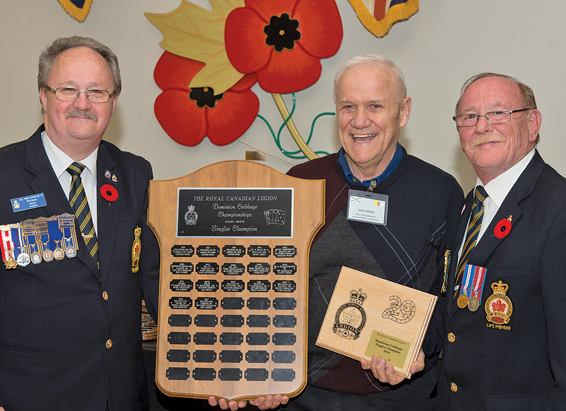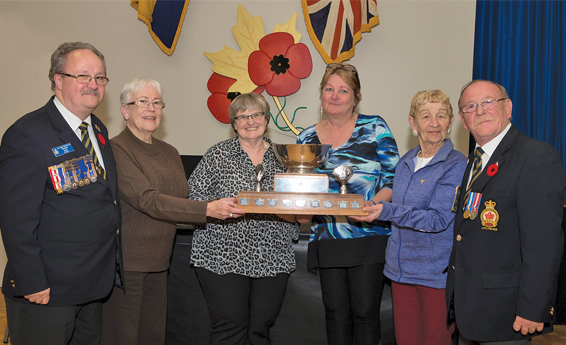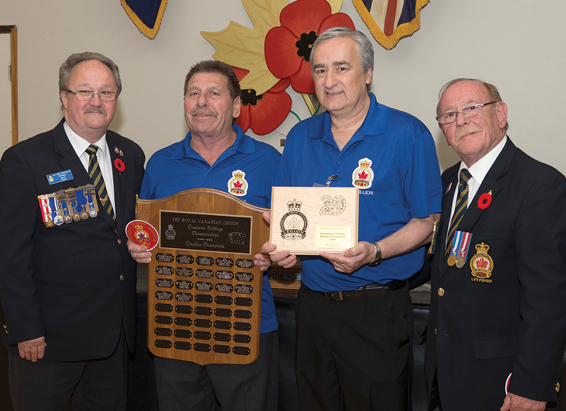
Gary Moore was nine or 10 years old when he started playing cribbage with his Uncle Bertie by lamplight at their old family home in Pleasant Bay, near Cheticamp, N.S.
Uncle Bertie was a farmer and fisherman out of the Cape Breton village of Red River just off the Cabot Trail, and he was a mean crib player. Moore would spend long hours counting cards—15-2, 15-4, and a pair for six—and pegging his scores on an old wooden board, more often than not in futile efforts to defeat his uncle.
“He was very strict,” Moore, now retired in Dartmouth, N.S., recalled after winning the singles title in his first appearance at the Dominion Cribbage Championships in Victoria held April 27-29. “He would look at our hands and he would sometimes say, ‘oh, that’s not right’ and make us count it over again.
“He’d let us make our mistakes and then correct us. I’d beat Uncle Bertie now and then—not too often, mind you, and certainly not right away,” he said.
Uncle Bertie had a son, Lloyd, who fought with the North Shore (New Brunswick) Regiment in the Second World War. When Lloyd heard that Moore’s mother—his aunt—was pregnant, he wrote her a letter around D-Day and asked her, if the baby was a boy, would she name him after him.
Gary Lloyd Moore was born a short time later, and his mother wrote the 19-year-old Lloyd to tell him that they had, indeed, given her boy his name. Lloyd never got the news. He was killed in action on Aug. 8, 1944. The letter was returned unopened.
The name of Lloyd Robert Moore appears on page 397 of the Second World War Book of Remembrance in the Peace Tower on Parliament Hill. He is buried alongside some 3,000 of his Allied comrades in the Bretteville-sur-Laize Canadian War Cemetery, on the road to Falaise just south of Caen, France.
He died late in the battle of Normandy, two days after Caen was liberated. Canadian and Polish troops faced furious opposition as they headed south to close the Falaise Gap and prevent German forces from escaping the Allied invasion.
There were seven siblings in Moore’s father’s family, and there would be many cousins for him to play crib with—singles and doubles. A member of Dartmouth’s Centennial Branch, he tallied 16 points in 18 games against his nine provincial opponents in Victoria, edging Saskatchewan’s Linda Beckman, who had 14.
Moore served in the merchant marine for years before starting a construction business in Dartmouth. He still maintains a home in Cape Breton.
The British Columbia/Yukon doubles pairing of Barry Dillon and Richard Falle, from the host Prince Edward Branch in the Victoria suburb of Langford, B.C., stretched their winning streak to three in a row and five of the past six doubles titles.
Their dynasty started in 2013 and was interrupted only in 2015 by the Stoughton, Sask., pairing of Beckman and her late mother, Eleanor Adams. Dillon and Falle ran away with the 2018 title, notching seven skunks as they racked up 20 points, defeating Alberta-Northwest Territories and Newfoundland and Labrador by eight.

The host Prince Edward Branch was organized by a small group of First World War veterans in 1927, the year after The Royal Canadian Legion was formed. Located not far from the navy’s Pacific headquarters at Esquimault, B.C., its walls document a rich history of military service and sacrifice, much of it on the sea.
There’s a shrine to HMCS Guysborough, a minesweeper torpedoed by U-868 in the Bay of Biscay on March 17, 1945, two years to the day after she left the North Vancouver shipyard for Halifax. More than half her crew of 93 died, all but two in the 19 hours it took for a pair of frigates to arrive at the scene. They came from every province and Newfoundland; three of the dead were from Victoria. U-868’s captain surrendered his vessel two months later at Bergen, Norway.
Today, the Langford branch thrives, thanks to some savvy management from the likes of President Norm Scott, a hands-on Legion member of 27 years, and his predecessors. The 1,300-member branch brings in $17,000 a month from 147 seniors’ housing units it built on the property and is planning to replace its expansive 50-year-old hall, which is booked most nights for Legion and other events.
“No. 1, we’re a business,” Scott said. “And you have to treat it like a business. You can’t treat it like you did back in the ’60s, ’70s and ’80s, like a boys’ club, because if you treat it in that sense, you’re not going to be here tomorrow.”
It was Scott who waited until 1:30 a.m. at the Victoria airport for an overdue flight out of Toronto loaded with tournament volunteers and participants.
Belinda LeBlanc chaired the organizing committee of Lenora Peatt, Fran Raglione, Jess Bamborough, Jeannie Caspersen and Nance Maki, all of whom laboured for more than six months, fundraising with draws, raffles and dances to prepare for some 48 cribbage players from across Canada. Adam LeBlanc and Ray Hyde also drove.
Norman Shelton, representing the Dominion Command Sports Committee, was ever-present throughout the three-day event. He and Scott placed a wreath at the table for the fallen during the opening ceremony on the Saturday.

2018 Results
Team: Que. (Montcalm Memorial Br., Rawdon) 27;
Man.-N.W.O. (The Pas Br.) 25; P.E.I. (Kingston Br., New Haven) 24; N.L. (Pleasantville Br.,
St. John’s) 22; Alta-N.W.T. (Calgary Br.) 20; B.C./Yukon (Westbank Br.) 20; N.S./Nunavut (Centennial Br., Dartmouth), N.B. (Havelock Br.) 19; Ont. (Col. Alex Thompson Memorial, Mississauga), Sask. (Tompkins Br.) 18.
Doubles: B.C./Yukon (Prince Edward Br., Victoria) 20; Alta.-N.W.T. (Calgary Br.) 12;
Man.-N.W.O. (Prince Edward Br., Winnipeg) 12; Que. (Montcalm Memorial Br.) 11; N.S./Nunavut (Centennial Br.) 11; N.L. (Pleasantville Br.) 11; Sask. (Tecumseh Stoughton Br., Stoughton) 10; Ont. (Col. Alex Thompson Memorial Br.) 10; N.B. (Havelock Br.) 8; P.E.I. (Kingston Br.) 5.
Singles: N.S./Nunavut (Centennial Br.) 16; Sask. (Tecumseh Stoughton Br.) 14; B.C./Yukon (Cranbrook Br.) 12; Man.-N.W.O. (St. James Br., Winnipeg) 11; Que.(Montcalm Memorial Br.) 10; Ont. (Col. Alex Thompson Memorial Br.) 10; N.B. (Havelock Br.) 8; P.E.I. (Kingston Br.) 7; Alta-N.W.T. (Calgary Br.) 7; N.L. (Pleasantville Br.) 6.
Advertisement












